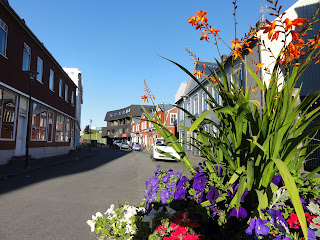 |
| Hengill Power Plant - Geothermal source of energy in Iceland |
As of July 6th,
the instruments were almost set up and the supplies that we ordered here had
arrived, allowing us to hook up our carrier gas to the gas chromatograph. The
hydrogen generator has been running well, which was a relief since we were
nervous about the effect travel might have on it. We have had a difficult time getting the gas
chromatograph up and running, as it seems that the oven is not warming up. We are hoping that this will be a simple fix.
We are trying to find a better location
to set up the instrument to see if we are simply not drawing enough power in
our current location and whether that could be contributing to our technical
issues. So, after brainstorming and
trying several problem-solving approaches, we decided to take a break from the
lab and we went out to the field in the afternoon to see the Hengill watershed
for the first time. It is absolutely
beautiful! The drive to get there is a
little frightening, because the watershed is located behind the Hengill Power
Plant, and we must drive off-road, around a mountain to get there. But, it made the trip all the more
exciting! The purpose of the Hengill
Power Plant is to meet the increasing demand for electricity and hot water for the Icelandic people. It is the largest geothermal plant in Iceland and the second largest in the world. Geothermal energy originates from the heat
that is retained within the Earth and can be readily harnessed in areas with high tectonic and volcanic activity, like Iceland, where this heat source is close to the surface. It is among one of the most cost effective
heating and cooling energy source available today and is roughly 25-50% more efficient than traditional (fossil fuel based) heating
methods.
 |
| Hengill watershed - our study site |
Before
we headed for the Hengill watershed, Wyatt Cross, the lead U.S. scientist on
this project (a professor at Montana State University), said, “It will be about a
20 minute drive to the site, and then there will be one difficult spot before we
get to the streams.” We all laughed thinking,
how bad can it be? We followed Dr. Cross
to the site, and along the way about every two minutes we’d say, “do you think
this is the spot he was talking about?”
Well, we said that about 8 times before actually arriving at THE spot
where we were driving on the side of the mountain, almost parallel to the
ground because the road is not filled in!
It was a little unsettling, but we made it just fine. Whew!! Dr. Welter is convinced that it will be
an easy fix; all we have to do is get some shovels and fill it the spot with dirt and
rocks. It’s going to take a little elbow
grease, but I have a feeling we will be fixing this spot in the road before the summer
is over because she did not like driving over it yesterday.
 |
| Dr. Welter holding Nostoc |
The
watershed is so vast; rocky mountainsides covered with moss and tundra grasses are
visible in every direction among the streams that emerge from the hill slopes. We
were able to drive close to research stream one, and we walked the rest of the
way to see all 17 streams. One of the
many reasons this project is taking place in Iceland is due to the natural
temperature gradient among the streams within the watershed. We
measure the water temperature in each stream to see the true variation and I was the temperature taker on Thursday. Using a digital thermometer, I placed the
reading end into the water and after a few seconds the temperature would
stabilize, indicating the stream’s water temperature. Not a challenging job, but very necessary and
essential to our research. Variation in
temperature plays a role in the development of certain algal species and affects
their growth rate, and we saw incredible variation in the abundance and
diversity of species across the streams.
Each stream we observed looked completely different, not just because of
location, temperature, and size, but the variation among algal species was incredible. Dr. Welter was identifying Nostoc, Anabaena, and many other nitrogen fixers left and right; they are
all over the place! I am going to focus
a majority of my time on identification of the different species and looking for
growth patterns to better explain their variation across the watershed. Upon first glance, it seems that the warmer
streams contained more nitrogen fixers than the cooler streams. I am excited to discover which species inhabit
the streams and determine what other factors could be influencing the growth
rates of the cyanobacteria in this amazing place!
























